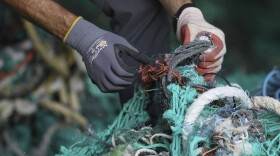State-wide unemployment remains at more than ten-percent in Hawaii, among the highest levels in the country. To create jobs, one local organization has brought back an idea from the Great Depression: paying unemployed workers to do environmental restoration.
For several weeks, the whine of chainsaws and rumble of woodchippers have been heard around the shores of Pearl Harbor.
Work crews have been clearing invasive mangroves from coastal streams that empty into Hawaii’s most famous body of water.
Amanda Millin, a field crew manager overseeing a team of five, says red mangrove is choking the Pearl Harbor ecosystem.
“Everywhere else in the tropics, all around the world, mangrove sequesters carbon, creates biodiversity, it’s erosion control but here in Hawaii mangrove is invasive and it takes over,” she explains.
Millin and her crew are among the 350 people in Hawaii currently being paid to do this type of conservation work by a CARES Act-funded grant.
Across the country, states and cities are racing to spend billions of dollars in federal pandemic assistance money before the deadline at the end of this month.
A partnership between the state Department of Business, Economic Development, and Tourism and a local non-profit has used some of the funds to bring back an idea for creating jobs from the era of the Great Depression.
In his 1933 inaugural address, President Franklin Delano Roosevelt highlighted the need to reduce unemployment, which peaked at almost 25% nationally, describing masses of unemployed citizens facing “the grim problem of existence and an equal great number [who] toil with little return.”
As part of his New Deal, FDR created the Civilian Conservation Corps as an attempt to provide work for the unemployed. The program gave jobs building trails and planting trees to some 3 million Americans during the Depression.
Hawaii’s modern-day version is called the Aina Corps and was created by the local non-profit Kupu. Kawika Riley, the group’s Director of Government Relations, says participants will work on either environmental conservation and agriculture.
“The goal is to find displaced workers and recent graduates who’ve been affected by the COVID downturn and then match them with green economy jobs and training for as long as the CARES funding allows,” Riley explained.
Since October, the Kupu Aina Corps has employed around 350 people who are paid at least 15 dollars an hour plus healthcare.
In addition to environmental benefits, Riley estimates that for every dollar spent, the program returns $1.35 to the local economy.
The Aina Corps also provided workers for non-profits who normally rely on volunteer groups – something restricted during the pandemic.
“We all needed people, people needed jobs, CARES money did that,” says Sandy Ward, Executive Director of Malama Pu’uloa, the group carrying out mangrove removal around Pearl Harbor.
However those benefits may soon disappear.
Congress mandated that CARES funds must be spent by the end of the year, which means the 350 Aina Corps workers will likely be out of a job come January.
The various non-profits involved in the program are trying to find alternate sources of funding to preserve as many jobs as they can after CARES funding expires.
Mangrove crew leader Amanda Millin is optimistic about the possibility of finding more grant funding, but says uncertainty over the future is taking its toll on everyone.
“It’s definitely unsettling and it’s a huge risk,” she admits.
“I’m constantly reminding myself that I think it will pan out and it’s worth the risk.”
Without new funding, conservation groups face the loss of experienced staff and Aina Corps workers will be thrust into the worst job market in decades.



